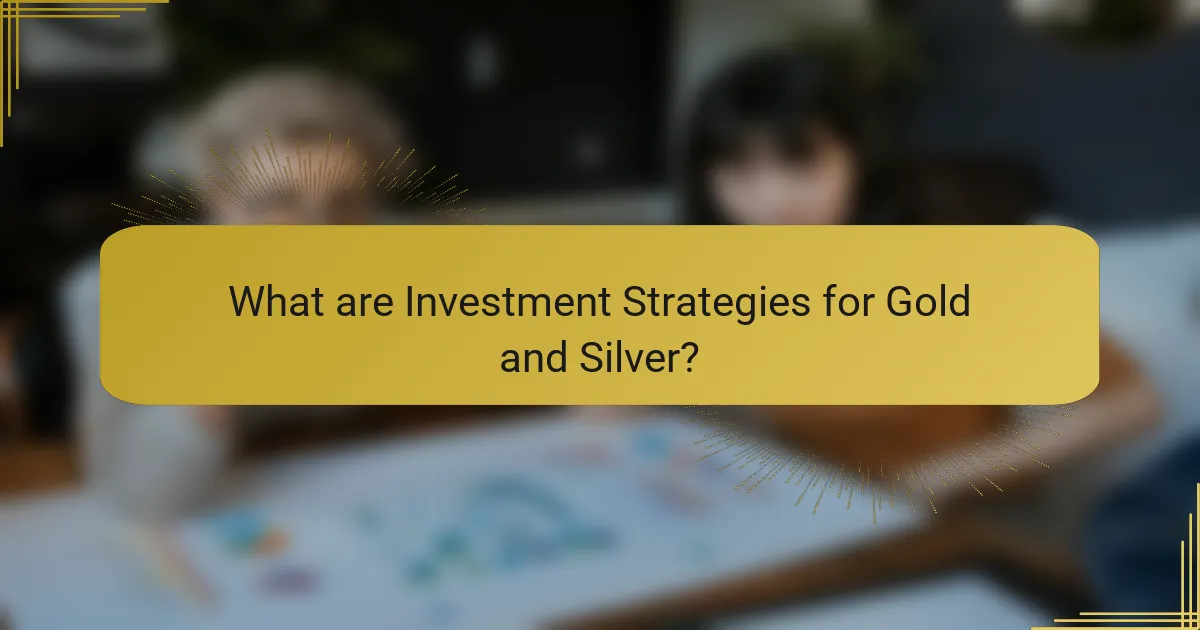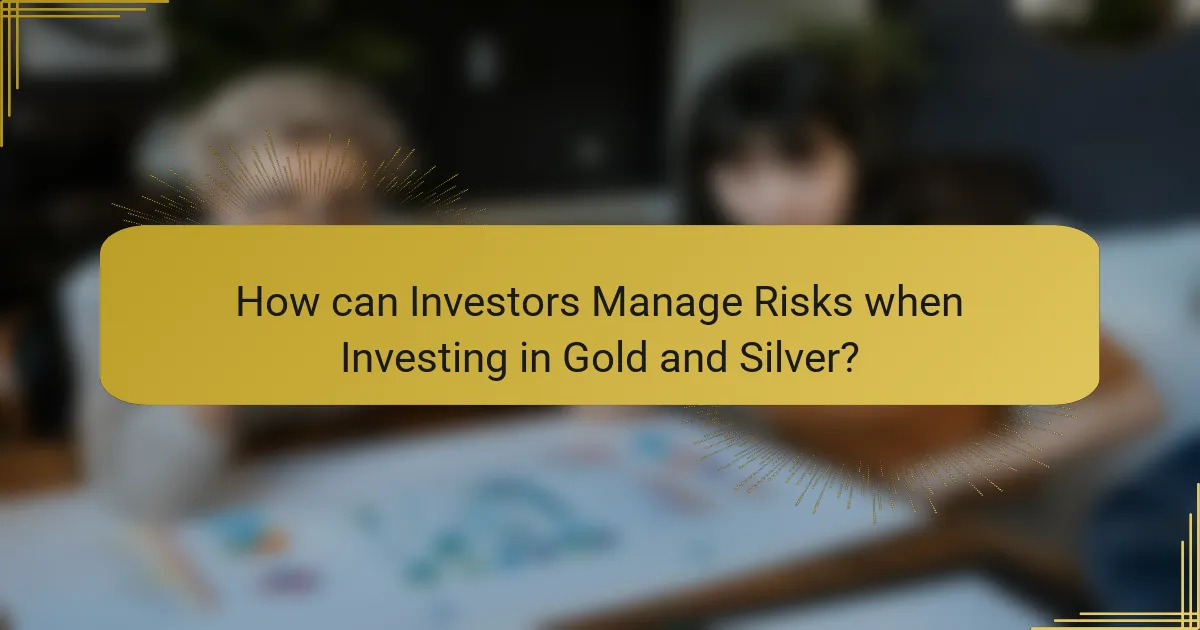Investment strategies for gold and silver focus on diversification, hedging against inflation, and long-term holding. Diversification involves incorporating these precious metals into a broader investment portfolio to mitigate risk, as they often exhibit low correlation with traditional assets like stocks and bonds. Gold and silver serve as effective hedges against inflation, historically preserving value during economic downturns. This article will explore the benefits of these strategies, including how they enhance portfolio stability, manage risks, and capitalize on the potential appreciation of gold and silver prices over time. Additionally, it will address the importance of regular portfolio review and risk management techniques such as stop-loss orders and market trend awareness.

What are Investment Strategies for Gold and Silver?
Investment strategies for gold and silver include diversification, hedging against inflation, and long-term holding. Diversification involves including gold and silver in a broader investment portfolio to reduce risk. This strategy is effective as precious metals often move independently of stocks and bonds. Hedging against inflation is another strategy, as gold historically preserves value during inflationary periods. Long-term holding capitalizes on the potential appreciation of gold and silver prices over time. Historical data shows that gold prices increased by over 400% from 2000 to 2020, indicating its potential as a long-term investment.
How do these strategies differ from other investment approaches?
Investment strategies for gold and silver differ from other investment approaches primarily due to their focus on asset preservation and hedge against inflation. Unlike stocks or bonds, gold and silver are tangible assets that often retain value during economic downturns. These strategies emphasize diversification, reducing overall portfolio risk by including precious metals. Historical data shows that during market volatility, gold prices tend to rise, serving as a safe haven. Additionally, gold and silver investments often require different management techniques, such as physical storage or dealing with market premiums. This unique approach contrasts with conventional investments that may rely more on market performance and yield.
What are the key characteristics of gold and silver as investment assets?
Gold and silver are highly regarded investment assets due to their intrinsic value and historical significance. Gold is often viewed as a safe-haven asset during economic uncertainty. It tends to retain value when currencies fluctuate. Silver, while also a precious metal, has industrial applications that can influence its price. Both metals are considered hedges against inflation. They provide portfolio diversification due to their low correlation with traditional assets. Gold has a finite supply, making it a scarce resource. Silver is more abundant but still limited, which contributes to its investment appeal. Historical performance shows that both metals can appreciate over time, especially during market downturns.
How do market conditions influence these investment strategies?
Market conditions significantly influence investment strategies for gold and silver. When economic uncertainty rises, investors often seek safe-haven assets like gold and silver. This shift can drive prices up, impacting strategy decisions. Conversely, in a strong economy, demand for these precious metals may decline, prompting a reevaluation of investment approaches.
Additionally, inflationary pressures can lead to increased interest in gold and silver as hedges against currency devaluation. Historical data shows that during periods of high inflation, gold prices have often surged. Interest rates also play a crucial role; lower rates typically boost gold and silver investments as opportunity costs decrease.
Therefore, understanding market conditions is essential for adapting investment strategies effectively.
Why should investors consider gold and silver?
Investors should consider gold and silver as a hedge against inflation and economic uncertainty. These precious metals have historically maintained their value during financial downturns. For instance, during the 2008 financial crisis, gold prices surged while stock markets plummeted. Gold and silver also provide portfolio diversification, reducing overall risk. A balanced portfolio with metals can mitigate losses from volatile assets. Additionally, gold has a long-standing reputation as a safe-haven asset. According to the World Gold Council, demand for gold remains strong, driven by investment and central bank purchases. Silver, while more volatile, offers industrial applications that can drive demand in growing sectors. Thus, both metals serve as strategic investments in uncertain times.
What historical performance trends exist for gold and silver investments?
Gold and silver investments have shown distinct historical performance trends. Gold typically acts as a safe-haven asset during economic uncertainty. For instance, during the 2008 financial crisis, gold prices surged by approximately 25%. Silver, while more volatile, often tracks gold’s performance. Over the last two decades, gold has appreciated around 500%, while silver has increased by about 400%. Additionally, gold tends to outperform silver in times of inflation. Historical data indicates that gold’s value increases when inflation rates rise. In contrast, silver may perform better during economic recovery phases. Overall, both metals have demonstrated their utility in diversifying investment portfolios.
How do gold and silver serve as a hedge against inflation?
Gold and silver serve as a hedge against inflation by maintaining their value when currency purchasing power declines. During inflationary periods, central banks often increase money supply, leading to currency devaluation. Gold and silver, being tangible assets, typically retain value as they are not directly affected by currency fluctuations. Historical data shows that during high inflation years, such as the 1970s, gold prices rose significantly, reflecting its role as a store of value. Furthermore, the demand for precious metals often increases in uncertain economic times, reinforcing their status as a safe haven. This relationship has been observed in various economic studies, which highlight the effectiveness of gold and silver in preserving wealth during inflationary pressures.

What are the Diversification Benefits of Investing in Gold and Silver?
Investing in gold and silver provides significant diversification benefits. These precious metals often have a low correlation with traditional asset classes like stocks and bonds. This means they can help reduce overall portfolio risk. During economic downturns, gold and silver tend to retain value better than equities. Historical data shows that gold prices rose by over 25% in 2008 while many stock indices fell sharply. Silver also acts as a hedge against inflation. Investors often turn to these metals during periods of currency devaluation. Consequently, including gold and silver can enhance portfolio stability and protect against market volatility.
How does diversification enhance investment portfolios?
Diversification enhances investment portfolios by spreading risk across various assets. This strategy reduces the impact of poor performance in any single investment. When one asset class declines, others may remain stable or increase in value. For example, during economic downturns, gold often performs well while stocks may falter. A diversified portfolio can include stocks, bonds, real estate, and commodities like gold and silver. Studies show that diversification can improve risk-adjusted returns. According to a study by the CFA Institute, diversified portfolios have historically outperformed concentrated ones over the long term. Thus, diversification is a key principle in effective investment strategy.
What role do gold and silver play in risk mitigation?
Gold and silver serve as effective tools for risk mitigation in investment portfolios. They typically retain value during economic downturns. Historical data shows that these metals often increase in price when stock markets decline. For instance, during the 2008 financial crisis, gold prices surged by over 25%. This behavior makes them a hedge against inflation and currency fluctuations. Investors often allocate a portion of their assets to these metals to reduce overall portfolio volatility. Additionally, gold and silver have low correlation with traditional assets like stocks and bonds. This diversification helps stabilize returns and protect against losses in turbulent markets.
How can gold and silver investments complement other asset classes?
Gold and silver investments can complement other asset classes by providing diversification and reducing overall portfolio risk. These precious metals often have a low correlation with stocks and bonds. During economic downturns, gold and silver tend to retain or increase their value. Historical data shows that gold has performed well during periods of inflation and market volatility. For instance, between 2000 and 2020, gold prices increased significantly while stock markets experienced fluctuations. This characteristic makes gold and silver effective hedges against inflation. Including these metals in an investment portfolio can enhance stability and potential returns. Therefore, they serve as a strategic asset class for investors seeking balance and risk management.
What are the potential risks associated with gold and silver investments?
Gold and silver investments carry several potential risks. Market volatility can lead to significant price fluctuations. Economic downturns often affect precious metal demand negatively. Regulatory changes may impact mining operations and market accessibility. Storage and insurance costs can eat into profits. Additionally, liquidity issues may arise during market downturns, making it hard to sell. Historical data shows that gold prices can drop sharply, as seen in 2013 when gold fell by 28 percent. Silver also experienced volatility, with prices falling over 50 percent from 2011 to 2015.
How does volatility in precious metal markets impact investment strategies?
Volatility in precious metal markets significantly influences investment strategies. Investors often adjust their portfolios in response to price fluctuations. Increased volatility can lead to heightened risk perception. This prompts investors to diversify their holdings to mitigate potential losses. For example, during periods of high volatility, gold often serves as a safe haven. In 2020, gold prices surged by over 25% amid market uncertainty, demonstrating its protective qualities. Conversely, low volatility may encourage more aggressive investment strategies. Investors might allocate more capital to precious metals when prices stabilize. Historical data shows that strategic positioning during volatility can enhance long-term returns.
What factors contribute to the risk profile of gold and silver investments?
The risk profile of gold and silver investments is influenced by several key factors. Market volatility affects the prices of these metals significantly. Economic indicators, such as inflation rates and interest rates, also play a crucial role. Geopolitical events can lead to sudden price fluctuations. Supply and demand dynamics directly impact the availability and pricing of these metals. Additionally, investor sentiment and market speculation can drive price changes. Historical data shows that gold and silver often act as safe havens during economic downturns, which can mitigate risk. However, their prices can be unpredictable, leading to potential investment losses.

How can Investors Manage Risks when Investing in Gold and Silver?
Investors can manage risks when investing in gold and silver by diversifying their portfolios. Diversification reduces the impact of poor performance in any single asset. Allocating funds across various assets, including stocks, bonds, and commodities, can mitigate overall risk. Investors should also consider the historical volatility of gold and silver. These precious metals often behave differently than traditional assets during market fluctuations.
Using stop-loss orders can provide a safety net against significant losses. These orders automatically sell assets when they reach a certain price. Additionally, investors should stay informed about market trends and geopolitical events. Awareness of factors influencing gold and silver prices can guide investment decisions.
Regularly reviewing and rebalancing the portfolio is crucial. This practice ensures that the investment strategy aligns with changing market conditions. By implementing these strategies, investors can effectively manage risks associated with gold and silver investments.
What risk management techniques are effective for these investments?
Effective risk management techniques for gold and silver investments include diversification, hedging, and stop-loss orders. Diversification reduces risk by spreading investments across various assets. This technique helps mitigate the impact of poor performance in any single investment. Hedging involves using financial instruments like options or futures to offset potential losses. This strategy can protect against price fluctuations in the metals market. Stop-loss orders automatically sell an asset when it reaches a specified price. This technique limits potential losses by exiting a position before further declines occur. Implementing these techniques can enhance the overall stability of an investment portfolio in gold and silver.
How can investors set stop-loss orders for gold and silver?
Investors can set stop-loss orders for gold and silver by specifying a price at which their holdings will automatically be sold. This helps limit potential losses in a declining market. To set a stop-loss order, investors must first choose a trading platform that supports this feature. Next, they should determine the stop-loss price based on their risk tolerance and market analysis. For instance, if gold is currently priced at $1,800, an investor might set a stop-loss order at $1,750. When the market price reaches this level, the order triggers a sale. This strategy is commonly used to manage risk effectively in volatile markets, such as those for gold and silver.
What role does portfolio rebalancing play in managing risks?
Portfolio rebalancing plays a critical role in managing risks by maintaining a desired asset allocation. It involves adjusting the proportions of different assets in a portfolio to counteract changes in market conditions. For example, if gold prices rise significantly, its weight in the portfolio may increase beyond the target allocation. This can lead to higher risk exposure if not corrected. Regular rebalancing ensures that the portfolio aligns with the investor’s risk tolerance and investment goals. Studies show that a disciplined rebalancing strategy can reduce volatility and improve risk-adjusted returns. By systematically selling overperforming assets and buying underperforming ones, investors can mitigate the risk of overexposure to any single asset class.
What long-term outlook should investors have for gold and silver?
Investors should have a cautiously optimistic long-term outlook for gold and silver. Historically, gold and silver have served as safe-haven assets during economic uncertainty. Over the past two decades, gold has appreciated significantly, with prices rising from around $300 in 2001 to over $1,800 in 2021. Silver has also shown substantial growth, increasing from approximately $4.00 in 2001 to around $25.00 in 2021.
Factors influencing this outlook include inflation concerns, currency fluctuations, and geopolitical tensions. Central banks globally have increased their gold reserves, indicating a strong demand for these metals. Additionally, the growing interest in sustainable and ethical investing may boost silver demand in renewable energy technologies.
Investors should consider gold and silver as part of a diversified portfolio. They can provide a hedge against inflation and currency devaluation. Maintaining exposure to these precious metals can help mitigate risks associated with traditional investments. Overall, the long-term outlook remains positive, driven by historical trends and current market dynamics.
How do economic indicators affect the future of gold and silver prices?
Economic indicators significantly influence the future prices of gold and silver. These indicators include inflation rates, interest rates, and employment data. Higher inflation typically drives investors towards gold and silver as a hedge, increasing their prices. Conversely, rising interest rates can decrease demand for these metals, leading to lower prices. Historical trends show that during economic uncertainty, like the 2008 financial crisis, gold prices surged as investors sought safe-haven assets. Additionally, the U.S. dollar’s strength affects gold and silver prices inversely; a stronger dollar often results in lower prices for these metals. In summary, economic indicators play a crucial role in shaping market perceptions and demand for gold and silver, ultimately impacting their future prices.
What trends should investors watch for in the gold and silver markets?
Investors should watch for increasing inflation and geopolitical tensions in the gold and silver markets. Inflation rates have been rising globally, impacting the purchasing power of fiat currencies. Historical data shows that gold often serves as a hedge against inflation. Additionally, geopolitical tensions can lead to increased demand for safe-haven assets like gold and silver. Recent events, such as conflicts or economic sanctions, typically drive investors toward these metals. Another trend is the growing interest in sustainable and ethical mining practices, influencing supply chains. Furthermore, central bank policies and interest rates significantly affect the prices of gold and silver. Monitoring these trends can provide investors with insights into market movements.
What practical tips can enhance investment strategies for gold and silver?
To enhance investment strategies for gold and silver, investors should consider diversification, market analysis, and timing. Diversification reduces risk by spreading investments across different assets. For example, combining gold and silver with stocks or bonds can stabilize returns. Conducting thorough market analysis helps identify trends and price movements. Investors should monitor geopolitical events, inflation rates, and currency fluctuations that affect precious metals. Timing purchases and sales is crucial. Historical data shows that buying during market dips often yields better long-term returns. Additionally, establishing a regular investment schedule can average out costs over time. Using reputable dealers ensures quality and authenticity in purchases.
The main entity of the article is investment strategies for gold and silver. The article provides a comprehensive overview of various strategies including diversification, hedging against inflation, and long-term holding, emphasizing their unique characteristics as tangible assets that retain value during economic downturns. It discusses how market conditions influence these strategies, the historical performance trends of gold and silver, and the importance of risk management techniques such as portfolio diversification and stop-loss orders. Additionally, the article outlines the long-term outlook for these precious metals, highlighting key economic indicators and trends that investors should monitor.